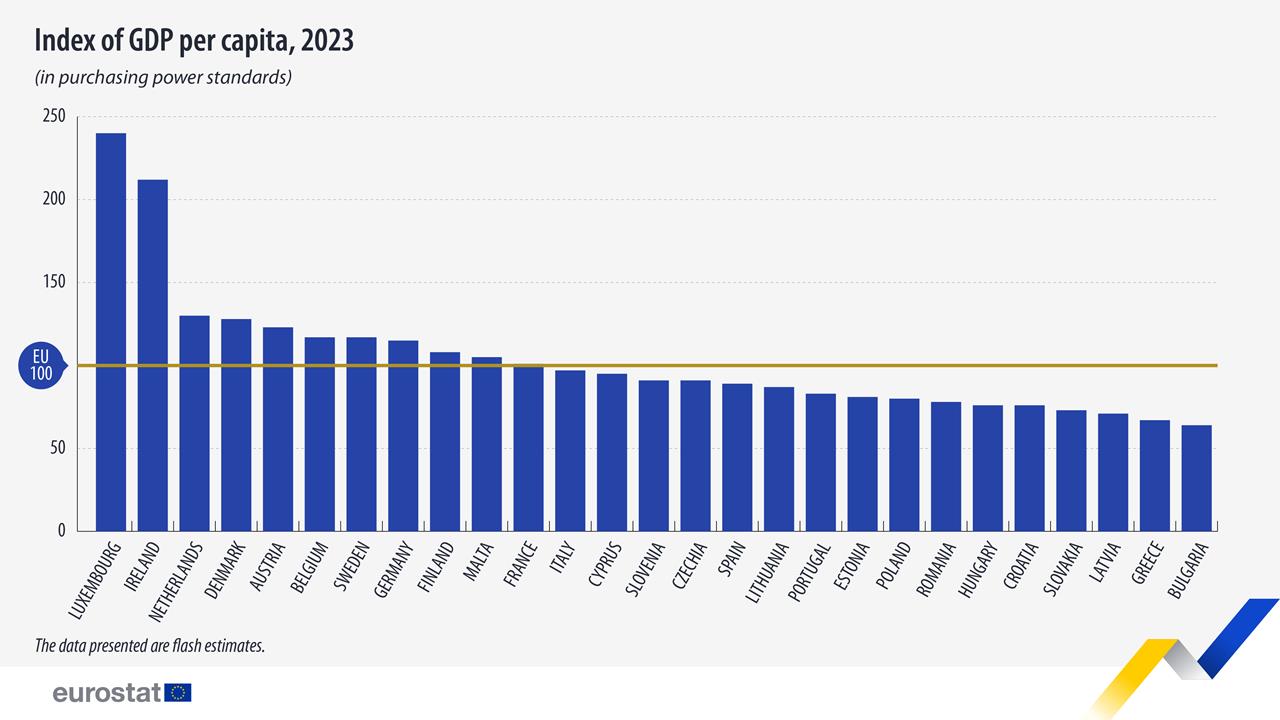Surprising: Romania more developed than Hungary, people may live better

Eurostat released its latest report on gross domestic product (GDP) per capita, measured in purchasing power standards, yesterday. According to the new data, Romania has surpassed Hungary, indicating that Romanians may enjoy a higher standard of living as they can afford more with their salaries compared to Hungarians. Hungary stands at 76% of the EU average.
According to the Eurostat, “in 2023, gross domestic product (GDP) per capita expressed in purchasing power standards ranged between 64% of the EU average in Bulgaria and 240% in Luxembourg.” These figures are based on Eurostat’s flash estimates of purchasing power parities and GDP for 2023, released yesterday. See their chart below:

“Luxembourg and Ireland had the highest levels (140% and 112% above the EU average, respectively), well ahead of the Netherlands (30% above the EU average), Denmark (+28%), and Austria (+23%),” Eurostat highlighted.
Romania surpasses Hungary for the first time
At the other end of the spectrum, Bulgaria (36% below the EU average), Greece (-33%) and Latvia (-29%) were positioned.
Hungarians often draw comparisons between themselves and their Eastern neighbour, Romania. In this instance, Romania has outpaced Hungary. The GDP per capita, expressed in purchasing power standards, stood at 78% in Romania, while Hungary lagged at 76%. 2023 marked the first year Romania managed to overtake Hungary, as reported by portfolio.hu. While there may be revisions, the Hungarian media outlet does not anticipate Romania falling behind Hungary as it did in 2022.

In Hungary, the economy contracted by 0.8% in 2023. Consequently, there is little anticipation of a rise in the GDP per capita, expressed in the purchasing power standards index. As a result, Croatia has caught up with Hungary, and Slovakia is only 3% behind.
A lot depends on the methodology, thus the index does not perfectly reflect the economic development level of a country. For instance, Luxembourg’s considerable divergence is attributed to its unique economic structure.
Read also:
- New Hungarian regulation would ban guest workers’ employment in more jobs – Read more HERE
- Ambitious plans: these are the economic goals the Orbán cabinet wants to achieve by 2030 – Details in THIS article
Source:




Of course Romania is doing better… for all their problems they don’t have Orban running their country….
Does not surprise me at all.
As per Mr. Trump: “What you’re seeing and what you’re reading is not what’s happening,”
Then there is the quote Orwell’s novel 1984:
“The party told you to reject the evidence of your eyes and ears. It was their final, most essential command.”
Let´s wait for a bit of Politician spin, conjuring up mirages of frolicking of unicorns.
This article is garbage. My daughter was in Romania a year ago and then in Hungary in the fall. She says that Romania is definitely not as developed. Anybody can draw a chart that says anything.
Even when Romania had lagged Hungary economically, they were able to enjoy life…… helps when they do not take themselves so seriously e.g. many Hungarians going back a century plus of history for some national and/or personal validation by claiming some faux nobility or blue blood…..
Romanians enjoy life a lot more than hungarians regardless of the economic differences. But lately western, canadian and american companies swarmed the country, especially in smaller cities like Brasov, Cluj, Iasi, Timisoara. Romania is a global IT hub with lots of western companies killing their development branches and moving them in Romania. So the difference will keep growing every year as Hungary lacks any clear economic prospects and opportunities under Orban.